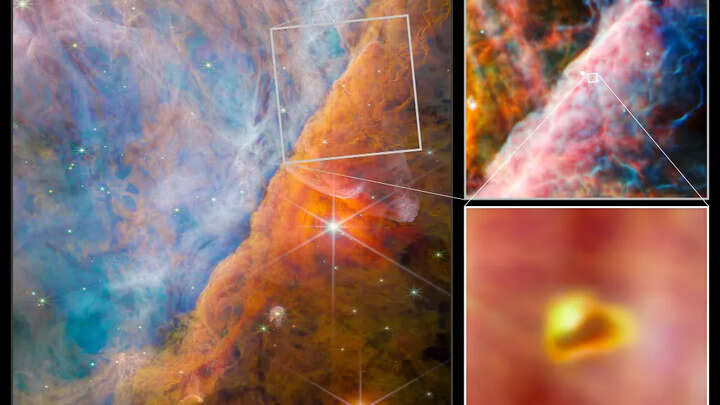James Webb telescope detects ‘crucial’ carbon molecule in distant space
NASA‘s James Webb Space Telescope has detected a key crucial carbon molecule in space for the first time. A team of researchers found this compound in the Orion Nebula which is about 1,350 light-years away from Earth.
The detected molecule, called methyl cation (pronounced cat-eye-on), is said to be a key life-building block as it plays an important role in forming more complex carbon-based molecules, NASA said in a tweet.
Why Carbon discovery is important
It is to be noted that Carbon compounds are essentially the foundation of all known life.
Read Also

Methyl cation was detected in a young star system, with a protoplanetary disk, known as d203-506- located in the Orion Nebula. A Nebula is a formation in space and is made of ionised, neutral, or molecular hydrogen and cosmic dust.
“The study of interstellar organic (carbon-containing) chemistry, which Webb is opening in new ways, is an area of keen fascination to many astronomers,” a research paper published in Journal Nature said.
With the discovery, scientists will now be working to understand how life developed on Earth. It may also help scientists understand how life could potentially develop elsewhere in the universe.
Read Also

“This detection not only validates the incredible sensitivity of Webb but also confirms the postulated central importance of CH3+ in interstellar chemistry,” said Marie-Aline Martin-Drumel of the University of Paris-Saclay in France, a member of the science team.
The star in d203-506 is a small red dwarf and the system is bombarded by strong ultraviolet (UV) light from nearby hot, young, massive stars.
“Typically, UV radiation is expected to destroy complex organic molecules, in which case the discovery of CH3+ might seem to be a surprise,” the paper read.
However, the team predicts that the radiation might have actually provided the necessary source of energy for CH3+ to form. Once the molecule is formed, it promotes additional chemical reactions to build more complex carbon molecules.
FacebookTwitterLinkedin
end of article

NASA‘s James Webb Space Telescope has detected a key crucial carbon molecule in space for the first time. A team of researchers found this compound in the Orion Nebula which is about 1,350 light-years away from Earth.
The detected molecule, called methyl cation (pronounced cat-eye-on), is said to be a key life-building block as it plays an important role in forming more complex carbon-based molecules, NASA said in a tweet.
Why Carbon discovery is important
It is to be noted that Carbon compounds are essentially the foundation of all known life.
Read Also

Methyl cation was detected in a young star system, with a protoplanetary disk, known as d203-506- located in the Orion Nebula. A Nebula is a formation in space and is made of ionised, neutral, or molecular hydrogen and cosmic dust.
“The study of interstellar organic (carbon-containing) chemistry, which Webb is opening in new ways, is an area of keen fascination to many astronomers,” a research paper published in Journal Nature said.
With the discovery, scientists will now be working to understand how life developed on Earth. It may also help scientists understand how life could potentially develop elsewhere in the universe.
Read Also

“This detection not only validates the incredible sensitivity of Webb but also confirms the postulated central importance of CH3+ in interstellar chemistry,” said Marie-Aline Martin-Drumel of the University of Paris-Saclay in France, a member of the science team.
The star in d203-506 is a small red dwarf and the system is bombarded by strong ultraviolet (UV) light from nearby hot, young, massive stars.
“Typically, UV radiation is expected to destroy complex organic molecules, in which case the discovery of CH3+ might seem to be a surprise,” the paper read.
However, the team predicts that the radiation might have actually provided the necessary source of energy for CH3+ to form. Once the molecule is formed, it promotes additional chemical reactions to build more complex carbon molecules.
FacebookTwitterLinkedin
end of article
